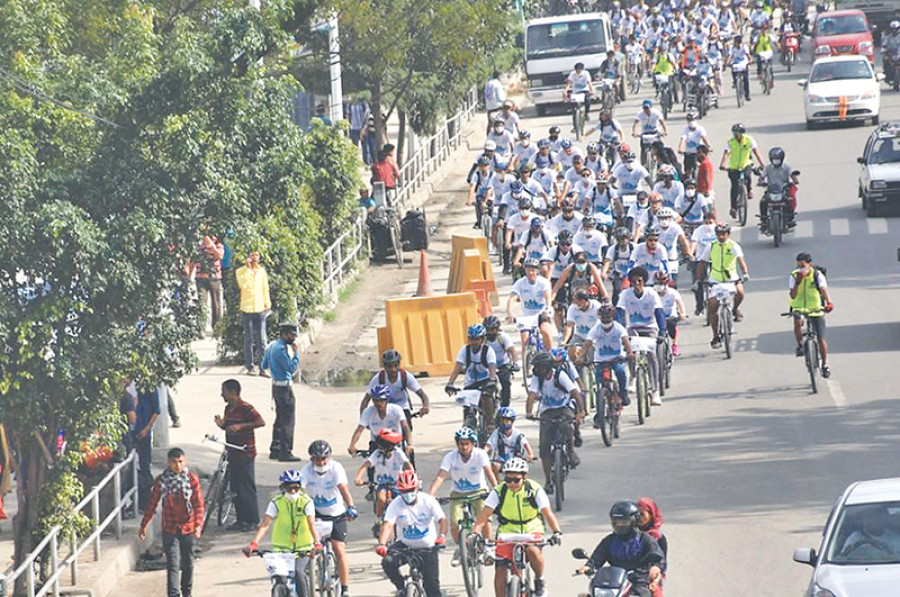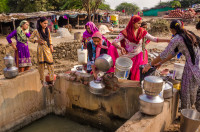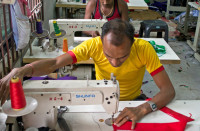Opinion
Shake a leg
The chronic traffic congestion in the Kathmandu Valley can be reduced by cycling
Shubhechchha Bhatta
The best cycle cities are places where speeds are slow, space for bicycling is clearly marked and plentiful, and there’s lots to see and do along the way considering the distances between places are not extreme. The best cities are those where cycles are taken as one of the main modes of transportation, and the policies and rules align accordingly. Kathmandu is facing the high end of pollution and congestion. The benefits of cycling are not hidden anymore, but there is a need to clarify some myths regarding cycle cities. Cycle city is not a less pedestrianised city. It is not a city without good, safe, reliable and fast public transportation. It is also not where you can’t ride your private vehicles.
Moving towards some international studies, even South Asians countries are taking concrete steps to support cycling for the betterment of traffic flow and congestion problems. Japan and Thailand rank second and third respectively in terms of bicycle ownership globally. Despite growing car ownership in China, only 17 percent of the households have cars, while 65 percent have bicycles, according to US-based Pew Research Centre. Taiwan, one of the world’s biggest manufacturers of bicycles, is bidding to become Asia’s cycling hub, and is proving that bicycles can be a major sustainability driver. Singapore, which is known for its efficient public transport system but has no established culture of cycling as a transport option, is one of the countries now keen on changing that.
UK-based Transport Research Laboratory researchers found that many people are taking up cycling to avoid congestion. In the Netherlands, researchers estimated a decrease in traffic jams by 3.8 million hours per year when building 675 km more cycle highways. Travel time by car decreases even more, by 9.4 million hours, when combined with electric bicycles. In the US, traffic congestion cost $63 billion in 2003 and 3.7 billion wasted hours each year. Since 2007, New York City has invested in a number of separated bicycle lanes to facilitate cycling in the city. A bicycle lane is a physically marked and separated lane dedicated to cycling that is on or directly adjacent to the roadway, but typically excludes all motorised traffic with some sort of barrier. Before the implementation of the measure, a fear of more congestion was stated in public discourse. Rather than increasing delays for cars, the protected bike lanes on Columbus Avenue in Manhattan, for example, actually improved travel times in the corridor.
The FLOW project of the European Directors of Roads and Europe’s National Road Research Centres developed a set of walking and cycling measures to reduce congestion. This portfolio describes the actual effects of different types of measures on congestion by presenting case studies of successfully implemented urban measures supportive of walking and cycling. The measures described have helped reduce congestion, or at least increased walking and cycling levels, without increasing congestion. In surveys of the distances cycled by cyclists in a day, it has been found that a typical average distance is 4-5 km.
Developing an integrated mode of transportation is a must for Nepali roads. The integration is made possible by bicycles that can be well integrated with high capacity transportation systems. It is certainly very difficult to provide cycle lanes on every road and street. Cycle lanes are just a tool, but all together, cycle city is a cycling culture in the city.
Both hard and soft measures should be developed. This means that if the roads are narrow, there does not need to be dedicated cycle lanes. There are many design aspects for cycle lanes. They can be shared with other vehicles or even with pedestrians in the core areas. It’s more about culture and policy.
Discussing which model suits Kathmandu would be another chapter, but it is certain that only public transportation can’t take passengers to their homes and workplaces. A holistic vision is needed. Bicycles should be seen as a major mode of transportation by every government agency. The Department of Roads should do it seeing congestion as a major problem in Kathmandu, and the Department of Health Services should do it seeing better health conditions for the new generation. Reducing congestion by following the boot, bike and bus policy for Kathmandu is the best way for every commuter, and the Integrated Municipal Cycle Master Plan is the first step Nepal’s local and federal bodies should take.
Bhatta is a transportation engineer.




 20.12°C Kathmandu
20.12°C Kathmandu










